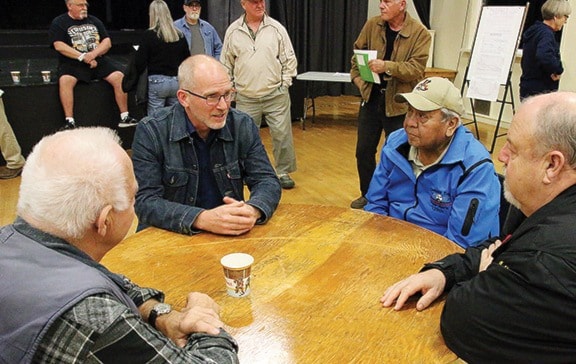If next summer is dry, then Catalyst could be pumping water over the weir from Cowichan Lake to keep the Cowichan River viable.
Catalyst’s Crofton operation has applied for a licence to pump water from the upstream side of the Lake Cowichan boat lock and weir (located near 300 North Shore Rd.) to the downstream side of the structure which will maintain up to five cubic meters per second of flow in the Cowichan River.
Approximately 30 per cent of this water will be used by Catalyst under its existing water licence, which authorizes water for the pulp and paper facility in Crofton and for domestic use by the Village of Crofton, while 70 per cent will be used for conservation purposes to support fish populations in the Cowichan River, according to the application.
Although it might appear to be a reaction solely to last summer’s drought, the move is based on years of observation, according to Harold Norlund, Crofton mill’s vice-president and general manager.
Built in 1957, the weir at Cowichan Lake is there “to hold back more of the spring and summer rains and snow melt and then release it back out during the fall,” he said. But even though summers were dry in the 1950s, there were snowy winters, too.
“People used to ski at Green Mountain [south of Nanaimo] and Mt. Arrowsmith in Port Alberni but now it has really changed. You don’t get the snow continuing into the July period and so the lake goes down way faster than it used to. The weir is there but the water won’t last,” he said.
This is not a new problem for the Cowichan Valley but “for the last few years it’s been gut-wrenching looking at it. It’s like [the weather] has shifted a month. It used to be dry from mid-July to early October but now it starts in May.”
Low water affects the migration of salmon but its reach goes far beyond that, Norlund said, pointing out that the outfalls from the sewage treatment operations run by Lake Cowichan and the Joint Utilities Board are also affected by the Cowichan River flow in a drought year.
“We have to try and hold enough water to last into Nov. 5. But it’s clear the fall rains don’t seem to come at the right time and you can tell that the river is going to go down. This is not just about if you run out of water, the mill has to shut down until it rains. There’s more to it,” Norlund said.
This past summer, Catalyst paid for an independent environmental group to study the river and then revised its application but people still must remember it’s only for two years, he said.
“We’re looking at a two-year opportunity where we could pump up to 49 days per year. This is a short term measure. For the long-term, for a hundred years, this is not an appropriate solution.”
Norlund said that DFO will decide which fish conservation efforts should be undertaken, if they are needed.
“The permit says we must keep the lower part of the river above 2.83 cu metres per second. Last summer, that flow got to around 3.1.”
The mill uses about 1.6 cubic metres per second itself, which is “far down from what it used in the past” partly because of new cooling systems.
Now, the idea is to be ready to help keep the river flowing, if needed.
The pumping option involves floating, low-velocity pumps.
“They float on the surface, like a fish pen, and would pump water over the weir without stirring up the bottom, continuing to flow until the fall rains came,” Norlund said.
The floating pumps would have to be fueled by a diesel generator because there “is not an easy place to get electricity there. If you were going to do it long term you would have to put in a power substation in. But this is only a two-year permit.”
Many people all along the watershed became anxious river watchers and are interested in Catalyst’s application.
Norlund said there were about 25 comments dropped in the box at an open house in Lake Cowichan last week.
There will not be an opportunity for a public meeting but people can still send in comments until Nov. 29 by emailing contact.us@catalystpaper.com or in writing to Catalyst Paper, Box 70, Crofton, B.C., V0R 1R0.
Objections to this application may also be filed with the Regional Water Manager, Ministry of Forests, Lands and Natural Resource Operations, 2080 Labieux Rd, Nanaimo, B.C., V9T 6J9.
